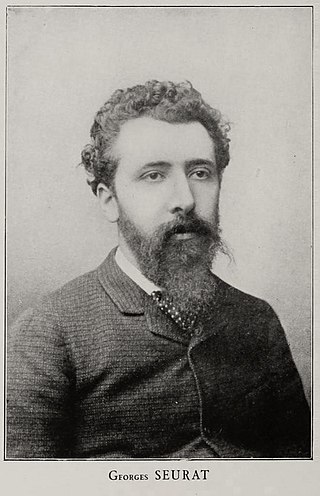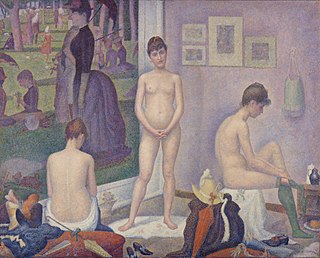
Georges Pierre Seurat was a French post-Impressionist artist. He devised the painting techniques known as chromoluminarism and pointillism and used conté crayon for drawings on paper with a rough surface.

Pointillism is a technique of painting in which small, distinct dots of color are applied in patterns to form an image.

Paul Victor Jules Signac was a French Neo-Impressionist painter who, with Georges Seurat, helped develop the artistic technique Pointillism.

Henri-Edmond Cross, born Henri-Edmond-Joseph Delacroix, was a French painter and printmaker. He is most acclaimed as a master of Neo-Impressionism and he played an important role in shaping the second phase of that movement. He was a significant influence on Henri Matisse and many other artists. His work was instrumental in the development of Fauvism.

Maximilien Luce was a prolific French Neo-impressionist artist, known for his paintings, graphic art, and his anarchist activism. Starting as a wood-engraver, he then concentrated on painting, first as an Impressionist, then as a Pointillist, and finally returning to Impressionism.

Neo-Impressionism is a term coined by French art critic Félix Fénéon in 1886 to describe an art movement founded by Georges Seurat. Seurat's most renowned masterpiece, A Sunday Afternoon on the Island of La Grande Jatte, marked the beginning of this movement when it first made its appearance at an exhibition of the Société des Artistes Indépendants in Paris. Around this time, the peak of France's modern era emerged and many painters were in search of new methods. Followers of Neo-Impressionism, in particular, were drawn to modern urban scenes as well as landscapes and seashores. Science-based interpretation of lines and colors influenced Neo-Impressionists' characterization of their own contemporary art. The Pointillist and Divisionist techniques are often mentioned in this context, because they were the dominant techniques in the beginning of the Neo-Impressionist movement.

Albert Dubois-Pillet was a French Neo-impressionist painter and a career army officer. He was instrumental in the founding of the Société des Artistes Indépendants, and was one of the first artists to embrace Pointillism.

Charles Angrand was a French artist who gained renown for his Neo-Impressionist paintings and drawings. He was an important member of the Parisian avant-garde art scene in the late 1880s and early 1890s.

Divisionism, also called chromoluminarism, is the characteristic style in Neo-Impressionist painting defined by the separation of colors into individual dots or patches that interact optically.

Asnières, now named Asnières-sur-Seine, is the subject and location of paintings that Vincent van Gogh made in 1887. The works, which include parks, restaurants, riverside settings and factories, mark a breakthrough in van Gogh's artistic development. In the Netherlands his work was shaped by great Dutch masters as well as Anton Mauve a Dutch realist painter who was a leading member of the Hague School and a significant early influence on his cousin-in-law van Gogh. In Paris van Gogh was exposed to and influenced by Impressionism, Symbolism, Pointillism, and Japanese woodblock print genres.

Hippolyte Petitjean was a French Post-Impressionist painter who practiced the technique of pointillism.

Le Chahut is a Neo-Impressionist painting by Georges Seurat, dated 1889–90. It was first exhibited at the 1890 Salon de la Société des Artistes Indépendants in Paris. Chahut became a target of art critics, and was widely discussed among Symbolist critics.

Parade de cirque is an 1887-88 Neo-Impressionist painting by Georges Seurat. It was first exhibited at the 1888 Salon de la Société des Artistes Indépendants in Paris, where it became one of Seurat's least admired works. Parade de cirque represents the sideshow of the Circus Corvi at place de la Nation, and was his first depiction of a nocturnal scene, and first painting of popular entertainment. Seurat worked on the theme for nearly six years before completing the final painting.

Models, also known as The Three Models and Les Poseuses, is a work by Georges Seurat, painted between 1886 and 1888 and held by the Barnes Foundation in Philadelphia. Models was exhibited at the fourth Salon des Indépendants in spring of 1888.

Opus 217. Against the Enamel of a Background Rhythmic with Beats and Angles, Tones, and Tints, Portrait of M. Félix Fénéon in 1890 is an oil-on-canvas painting by French Neo-impressionist artist Paul Signac, created in 1890. The work depicts the French art critic Félix Fénéon standing in front of a swirling, kaleidoscope background. The painting's bold approach—utilizing color, pattern, and brushstroke to blend representation with abstraction—highlights a pivotal moment in Neo-Impressionism's history, influenced by the close bond between the artist and the critic. This piece is not just an iconic portrayal of Fénéon, but also acts as a visual declaration for Neo-Impressionism, grounded in nineteenth-century color theory, and signals the onset of modernism. It has been in Museum of Modern Art in New York since 1991, having been donated by Mr. and Mrs. David Rockefeller.

Maria Sèthe at the Harmonium is an oil-on-canvas painting by the Belgian neo-impressionist painter Théo van Rysselberghe. It depicts a woman with blonde, worn-up hair and a purple dress, seen in profile gazing toward the left. The sitter was Maria Sèthe, who belonged to an affluent musical family with an interest in the arts. In the painting, she is seated at a harmonium but is not playing it.

Sailboats and Estuary is an oil-on-canvas painting by Belgian srtist Théo van Rysselberghe. Painted around 1887, it shows a coastal landscape elaborated in a Pointillist technique. Van Rysselberghe probably adopted the Pointillist manner after befriending Signac; however, the use of color in Sailboats and Esuary is nonetheless far more realistic than in paintings by Signac and other Neo-Impressionists, and reveals a tendency towards naturalism. The artwork has been in the collection of the Musée d'Orsay in Paris since 1982, on loan from the Louvre.

Portrait of Irma Sèthe is an oil on canvas painting by the Belgian neo-impressionist painter Théo van Rysselberghe. The work is a portrait, painted in pointillist style, of Irma Sèthe, one of the heiress of a musical Brussels family close to the painter, playing the violin. The work is now in the private collection of the Musée du Petit Palais in Geneva.

L'Escaut en amont d'Anvers, le soir or An Evening is an oil on canvas painting by Belgian painter Théo van Rysselberghe. Painted in 1892, the painting is considered a very good example of Van Rysselberghe's pointillist technique, which, by the time he painted this oeuvre, had been completely absorbed and adjusted by the Belgian artist.

In the Time of Harmony is a painting by the French post-impressionist artist Paul Signac, completed in 1895 in Saint-Tropez. This pointillist oil painting on canvas represents an idealized society by the seashore where numerous people perform different activities such as foraging, pétanque, reading, dancing, and painting. Shown at the Salon des indépendants in 1895, it has since been in the grand staircase of the Montreuil city hall in Seine-Saint-Denis.




















